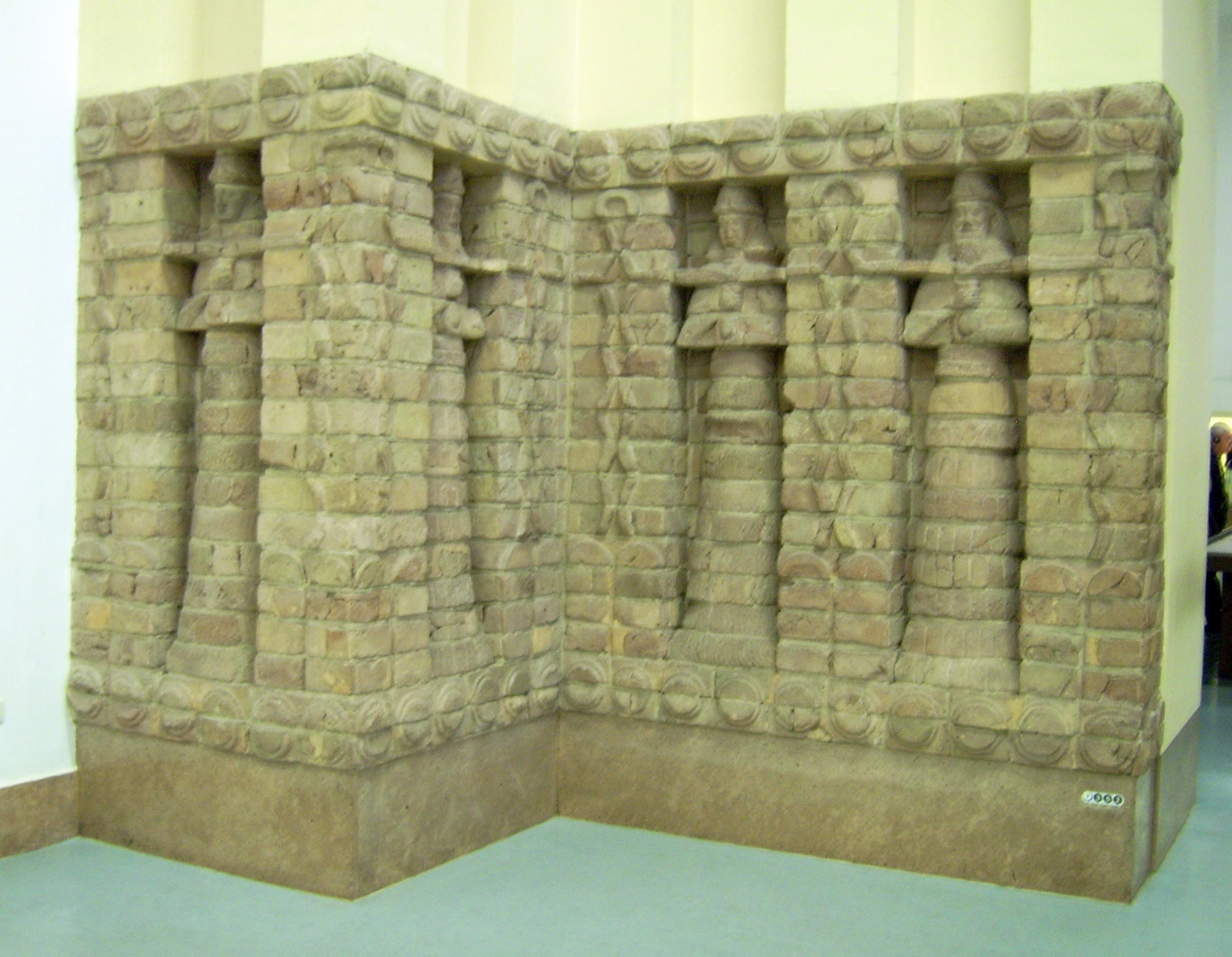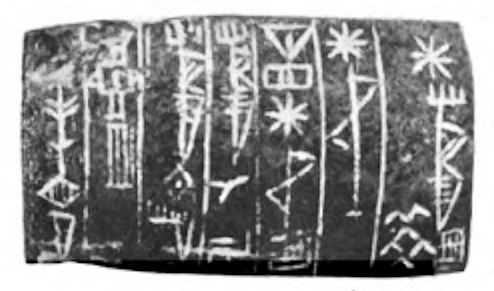|
Kudurru Of Kaštiliašu
The Kudurru of Kaštiliašu' is a fragment of an ancient Mesopotamian ''narû'', or entitlement stele, recording the legal action taken by Kassite king Kaštiliašu IV ( 1232–1225 BC) over land originally granted by his forebear Kurigalzu II ( 1332–1308 BC), son of Burna-Buriaš II to Uzub-Šiḫu or -Šipak in grateful recognition of his efforts in the war against Assyria under its king, Enlil-nirari. Along with the Tablet of Akaptaḫa, these are the only extant kudurrus from this king's short eight-year reign and were both recovered from Elamite Susa, where they had been taken in antiquity, during the French excavations under Jacques de Morgan at the end of the nineteenth century and now reside in the Musée du Louvre. The stele The surviving kudurru fragment is a crescent-shaped cross-section with convex surface inscribed with cuneiform and a concave side engraved with relief images. Where the stele tapers to the top, it carries representations of the gods Sîn (cre ... [...More Info...] [...Related Items...] OR: [Wikipedia] [Google] [Baidu] |
Jean-Vincent Scheil
Father Jean-Vincent Scheil (born 10 June 1858, Kœnigsmacker – died 21 September 1940, Paris) was a French Dominican scholar and Assyriologist. He is credited as the discoverer of the Code of Hammurabi in Persia. In 1911 he came into possession of the Scheil dynastic tablet and first translated it. After being ordained in 1887, he took courses in Egyptology and Assyriology at the '' École des Hautes Études'', and was a student at the Collège de France, where he was a pupil of Assyriologist Julius Oppert. In 1890/91 as a member of the French Archaeological Mission of Cairo, he took part in excavations at Thebes.Institut national d'histoire de l'art biography In 1892 he conducted excavations near |
Jacques De Morgan
Jean-Jacques de Morgan (3 June 1857 – 14 June 1924) was a French mining engineer, geologist, and archaeologist. He was the director of antiquities in Egypt during the 19th century, and excavated in Memphis and Dahshur, providing many drawings of many Egyptian pyramids. He also worked at Stonehenge, and Persepolis, and many other sites. He also went to Russian Armenia, as manager of a copper mine at Akhtala. "The Caucasus is of special interest in the study of the origins of metals; it is the easternmost point from which prehistoric remains are known; older than Europe and Greece, it still retains the traces of those civilizations that were the cradle of our own." In 1887-89 he unearthed 576 graves around Alaverdi and Akhatala, near the Tiflis- Alexandropol railway line. Early life He was born in Huisseau-sur-Cosson, Loir-et-Cher. His father Eugène, also called "Baron" de Morgan, was an engineer in mineral findings. His interests were in entomology and pre ... [...More Info...] [...Related Items...] OR: [Wikipedia] [Google] [Baidu] |
Sculpture Of The Ancient Near East
Sculpture is the branch of the visual arts that operates in three dimensions. Sculpture is the three-dimensional art work which is physically presented in the dimensions of height, width and depth. It is one of the plastic arts. Durable sculptural processes originally used carving (the removal of material) and modelling (the addition of material, as clay), in stone, metal, ceramic art, ceramics, wood and other materials but, since Modernism, there has been almost complete freedom of materials and process. A wide variety of materials may be worked by removal such as carving, assembled by welding or modelling, or Molding (process), moulded or Casting, cast. Sculpture in stone survives far better than works of art in perishable materials, and often represents the majority of the surviving works (other than pottery) from ancient cultures, though conversely traditions of sculpture in wood may have vanished almost entirely. In addition, most ancient sculpture was painted, which h ... [...More Info...] [...Related Items...] OR: [Wikipedia] [Google] [Baidu] |
Kudurru Boundary Stones
A kudurru was a type of stone document used as a boundary stone and as a record of land grants to vassals by the Kassites and later dynasties in ancient Babylonia between the 16th and 7th centuries BC. The original kudurru would typically be stored in a temple while the person granted the land would be given a clay copy to use to confirm legal ownership. Kudurrus are often linked to what are usually called "ancient kudurrus", land grant stones from the third millennium (typically Sargonic and Ur III) which serve a similar purpose though the word kudurru did not emerge until the 2nd millennium (Middle Babylonian in fact). Background The objects are traditionally called kudurru which is Akkadian for "frontier" or "boundary". because early epigraphers frequently found that word in the text and assumed they were placed in agricultural setting, not the temples they actually were. While there is consensus on the main group of kudurru there are other "debatable kudurru" for which opinio ... [...More Info...] [...Related Items...] OR: [Wikipedia] [Google] [Baidu] |
Adad-nirari I
Adad-nārārī I (1305–1274 BC or 1295–1263 BC short chronology) was a king of Assyria during the Middle Assyrian Empire. He is the earliest Assyrian king whose annals survive in any detail, and achieved major military victories that further strengthened Assyria. Early life His name is rendered in all but two inscriptions ideographically as md''adad-''ZAB+DAḪ, meaning "Adad (is) my helper," In his inscriptions from Assur he calls himself son of Arik-den-ili, the same filiations being recorded in the Nassouhi kinglist.Nassouhi kinglist, iii 23. He is recorded as a son of Enlil-nirari in the Khorsabad kinglistKhorsabad kinglist iii 17. and the SDAS kinglist,SDAS kinglist, iii 8. probably in error. Reign Early rule He boasted that he was the "defeater of the heroic armies of the Kassites (their Babylonian neighbors to the south), Qutu (their eastern Gutean neighbors), Lullumu (the Lullubi tribesmen of Ancient Iran immediately east of Assyria) and Shubaru ("northerners ... [...More Info...] [...Related Items...] OR: [Wikipedia] [Google] [Baidu] |
Chronicle P
Chronicle P, known as ''Chronicle 22'' in Grayson’s ''Assyrian and Babylonian Chronicles'' and ''Mesopotamian Chronicle 45'': "Chronicle of the Kassite Kings" in Glassner's ''Mesopotamian Chronicles'' is named for T. G. Pinches, the first editor of the text. It is a chronicle of the second half of the second millennium BC or the Kassite period, written by a first millennium BC Babylonian scribe. The tablet The chronicle is preserved on a single fragment 180 mm wide and 120 mm long and is in fairly poor condition. It is the lower third of what was originally a large clay tablet inscribed with two columns of Akkadian cuneiform per side, and is held in the British Museum, now bearing the museum reference BM 92701. Its provenance is unknown but the internal evidence from the script characteristics betrays it to be a late Babylonian copy. It was purchased by the museum from Spartali & Co in 1882 and originally given the accession number 82-7-4, 38. The text The text i ... [...More Info...] [...Related Items...] OR: [Wikipedia] [Google] [Baidu] |
Kassite Deities
Kassite deities were the pantheon of the Kassites ( Akkadian: ''Kaššû'', from Kassite ''Galzu''), a group inhabiting parts of modern Iraq (mostly historical Babylonia and the Nuzi area), as well as Iran and Syria, in the second and first millennia BCE. A dynasty of Kassite origin ruled Babylonia starting with the fifteenth century BCE. Kassites spoke the Kassite language, known from references in Mesopotamian sources. Many of the known Kassite words are names of Kassite deities. Around twenty have been identified so far. The evidence of their cult is limited, and only two of them, Šuqamuna and Šumaliya, are known to have had a temple. Other well attested Kassite deities include the presumed head god Ḫarbe, the weather god Buriaš, the sun god Saḫ and the deified mountain Kamulla. Overview Around two dozen of names Kassite deities have been identified in texts written in the Kassite language, a language isolate only known from references in Mesopotamian lexical texts ... [...More Info...] [...Related Items...] OR: [Wikipedia] [Google] [Baidu] |
Gula (goddess)
Gula (Sumerian language, Sumerian: "the great") was a Mesopotamian goddess of medicine, portrayed as a divine physician and midwife. Over the course of the second and first millennia BCE, she became one of the main deities of the Mesopotamian pantheon, and eventually started to be viewed as the second highest ranked goddess after Ishtar. She was associated with dogs, and could be depicted alongside these animals, for example on ''kudurru'' (inscribed boundary stones), and receive figurines representing them as votive offerings. While Gula was initially regarded as unmarried, in the Kassite period she came to be associated with Ninurta. In Babylon his role could also be fulfilled by Mandanu, while the god list ''An = Anum'' links Gula with Pabilsag and Abu. The circle of deities closely associated with her also included Damu and Gunura, who eventually started to be regarded as her children, as well as her sukkal (divine attendant) Urmašum, who might have been imagined as a dog-like ... [...More Info...] [...Related Items...] OR: [Wikipedia] [Google] [Baidu] |
Ugallu
A panel with two divine palace guards, one of which is Ugallu. Ugallu, the "Big Weather-Beast", ( Sumerian inscribed 𒌓𒃲𒆷/UD.GAL.LA, Akkadian: ''ūmu rabû'', meaning "big day"; or, better in this case: "big storm"). It was a lion-headed storm-demon and has the feet of a bird who is featured on protective amulets and apotropaic yellow clay or tamarisk figurines of the first millennium BC but had its origins in the early second millennium. The iconography changed over time, with the human feet morphing into an eagle's talons and dressing him in a short skirt. He was one of the class of ud-demons (day-demons), personifying moments of divine intervention in human life. Function As an ud-demon, Ugallu's function is to intervene in moments of disaster in a person's life, such as saving them from death. His affiliation with the day compares him with other light related deities, Shamash the sun, the star of Sirius, and Nuska, god of the lamp. Many of his rituals as described ar ... [...More Info...] [...Related Items...] OR: [Wikipedia] [Google] [Baidu] |
Ishtar
Inanna is the List of Mesopotamian deities, ancient Mesopotamian goddess of war, love, and fertility. She is also associated with political power, divine law, sensuality, and procreation. Originally worshipped in Sumer, she was known by the Akkadian Empire, Akkadians, Babylonian religion, Babylonians, and Assyrians as Ishtar. Her primary title is Queen of Heaven (antiquity), "the Queen of Heaven". She was the patron goddess of the Eanna temple at the city of Uruk, her early main religious center. In archaic Uruk, she was worshipped in three forms: morning Inanna (Inana-UD/hud), evening Inanna (Inanna sig), and princely Inanna (Inanna NUN), the former two reflecting the phases of her associated planet Venus. Her most prominent symbols include the Lion of Babylon, lion and the Star of Ishtar, eight-pointed star. Her husband is the god Dumuzid (later known as Tammuz), and her (attendant) is the goddess Ninshubur, later conflated with the male deities Ilabrat and Papsukkal. Inanna ... [...More Info...] [...Related Items...] OR: [Wikipedia] [Google] [Baidu] |
Shamash
Shamash (Akkadian language, Akkadian: ''šamaš''), also known as Utu (Sumerian language, Sumerian: dutu "Sun") was the List of Mesopotamian deities, ancient Mesopotamian Solar deity, sun god. He was believed to see everything that happened in the world every day, and was therefore responsible for justice and protection of travelers. As a divine judge, he could be associated with the Ancient Mesopotamian underworld, underworld. Additionally, he could serve as the god of divination, typically alongside the weather god Adad. While he was universally regarded as one of the primary gods, he was particularly venerated in Sippar and Larsa. The Moon God, moon god Nanna (Sumerian deity), Nanna (Sin) and his wife Ningal were regarded as his parents, while his twin sister was Inanna (Ishtar). Occasionally other goddesses, such as Manzat (goddess), Manzat and Pinikir, could be regarded as his sisters too. The dawn goddess Aya (goddess), Aya (Sherida) was his wife, and multiple texts describe ... [...More Info...] [...Related Items...] OR: [Wikipedia] [Google] [Baidu] |








